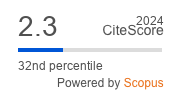ABSTRACT
In October 2023, the European Union adopted a new green energy policy, mandating a reduction in total final energy consumption to 763 Mtoe by 2030. To achieve these rigorous targets, which include the residential sector (accounting for approximately 25%), the scientific community must intensify efforts to integrate passive solar systems in energy-efficient buildings in the coming period. This paper numerically (using Google SketchUp and EnergyPlus software) investigates the novel energy-efficient building strategy that combines various traditional, bioclimatic, passive solar and green architectural solutions: earth-sheltered building, Trombe wall and horizontally placed pergolas (with seasonal tracking mechanism). The energy benefits of the presented strategy (scenario S3) are proven compared to the earth-sheltered building (scenario S2) and the above-ground building (scenario S1). All buildings are intended for the permanent residence of four-member families during the year and with the same room layout, habits and thermo-technical (space heating, space cooling, water heating, artificial lights and electric equipment) performance. Simulation results indicate that the annual electricity consumption for space heating in the earth-sheltered building with Trombe wall and pergolas (scenario S3) is 52.56% and 15.79% lower than the above-ground building (scenario S1) and the earth-sheltered building (scenario S2), respectively. Using pergolas (in front of the Trombe wall), the annual electricity consumption for space cooling in scenario S3 does not increase compared to scenario S2, while the savings compared to scenario S1 exceed 19%.
KEYWORDS
PAPER SUBMITTED: 2025-05-19
PAPER REVISED: 2025-06-20
PAPER ACCEPTED: 2025-06-24
PUBLISHED ONLINE: 2025-08-02
- ***, Intergovernmental Panel on Climate Change, www.ipcc.ch/
- ***, International Energy Agency, www.iea.org/
- El Azhary, K., et al., Energy Efficiency of a Vernacular Building Design and Materials in Hot Arid Climate: Experimental and Numerical Approach, International Journal of Renewable Energy Development, 10 (2021), 3, pp. 481
- Majewski, G., et al., Preliminary Results of Thermal Comfort Analysis in Selected Buildings, E3S Web of Conferences, 17 (2017), -, pp. 00056
- Yongxia, C., et al., Creating and Managing Green Residential Interior Design in Baotou Inner Mongolia, China, South Asian Journal of Social Sciences & Humanities, 5 (2024), 3, pp. 154
- Iwuanyanwu, O., et al., Cultural and Social Dimensions of Green Architecture: Designing for Sustainability and Community Well-Being, International Journal of Applied Research in Social Sciences, 6 (2024), 8, pp. 1951-1968
- Manzano-Agugliaro, F., et al., Review of Bioclimatic Architecture Strategies for Achieving Thermal Comfort, Renewable and Sustainable Energy Reviews, 49 (2015), -, pp. 736-755
- Liu, T., et al., Sustainability Considerations of Green Buildings: A Detailed Overview on Current Advancements and Future Considerations, Sustainability, 14 (2022), 21, pp. 14393
- Xu, W., et al., Research on the Sustainable Design Strategies of Vernacular Architecture in Southwest Hubei - A Case Study of the First Granary of Xuan'en County, PloS One, 19 (2024), 12, pp. 1-20
- Benardos, A., et al., Modern Earth Sheltered Constructions: A Paradigm of Green Engineering, Tunnelling and Underground Space Technology, 41 (2014), -, pp. 46-52
- Dewangan, S., Kapadia, Q. H., Modern Construction Techniques for Earth-Bermed Structures, Overcoming Structural and Material Challenges, International Journal of Innovative Research in Technology, 11 (2024), 7, pp. 404-409
- Hu, Z., et al., A Review on the Application of Trombe Wall System in Buildings, Renewable and Sustainable Energy Reviews, 70 (2017), C, pp. 976-987
- Nešović, A. M., Elevational Earth-Sheltered Buildings with Selective Coated Southern Facade Walls, Tehnika, 79 (2024), 3, pp. 259-266
- Briga Sá, A. C., et al., An Analytical Approach to Assess the Influence of the Massive Wall Material, Thickness and Ventilation System on the Trombe Wall Thermal Performance, Journal of Building Physics, 41 (2018) (5), 445-468
- Rabani, M., et al., Heat Transfer Analysis of a Trombe Wall with a Projecting Channel Design, Energy, 134 (2017), -, pp. 943-950
- Dabaieh, M., Elbably, A., Ventilated Trombe Wall as a Passive Solar Heating and Cooling Retrofitting Approach; A Low-Tech Design for Off-Grid Settlements in Semi-Arid Climates, Solar Energy, 122 (2015), -, pp. 820-833
- Hu, Z., et al., Comparative Study on the Annual Performance of Three Types of Building Integrated Photovoltaic (BIPV) Trombe Wall System, Applied Energy, 194 (2017), -, pp. 81-93
- Raeissi, S., Taheri, M., Optimum Overhang Dimensions for Energy Saving, Building and Environment, 33 (1998), 5, pp. 293-302
- Babota, F., et al., Determination of Optimal Dimensions of Fixed Shadowing Systems (Pergolas) to Reduce Energy Consumption in Buildings in Romania, Procedia Manufacturing, 22 (2018), -, pp. 358-363
- Cho, J., et al., Viability of Exterior Shading Devices for High-Rise Residential Buildings: Case Study for Cooling Energy Saving and Economic Feasibility Analysis, Energy and Buildings, 82 (2014), -, pp. 771-785
- Soydan, O., Evaluation of the Landscape Design of Kindergarten Gardens, Eurasian Journal of Agricultural Research, 8 (2024), 2, pp. 159-173
- Shibles, D. B., Yasalonis, A., Building a Pergola in a Demonstration Garden, Florida State Horticultural Society, 120 (2007), -, pp. 332-334
- Valjarević, A., et al., Long Term Monitoring and Connection Between Topography and Cloud Cover Distribution in Serbia, Atmosphere, 12 (2021), 8, pp. 964
- Yao, X., et al., Spatial Prediction of Landslide Susceptibility in Western Serbia Using Hybrid Support Vector Regression (SVR) with GWO, BAT and COA Algorithms, Geoscience Frontiers, 12 (2021), -, pp. 101104
- Milanović, A. R., et al., Earth-Sheltered House: A Case Study of Dobraca Village House Near Kragujevac, Serbia, Sustainability, 10 (2018), 10, pp. 3629
- Nešović, A., et al., Potential of Contemporary Earth-Sheltered Buildings to Achieve Plus Energy Status in Various European Climates During the Heating Season, Building Simulation, 17 (2024), 1, pp. 41-52
- Bajc, T., et al., CFD Analyses for Passive House with Trombe Wall and Impact to Energy Demand, Energy and Buildings, 98 (2015), pp. 39-44
- Ranđelović, D. J., et al., Impact of Trombe Wall Construction on Thermal Comfort and Building Energy Consumption.,Facta Universitatis, Series: Architecture and Civil Engineering, 16 (2018), 2, pp. 279-292
- Bogdanović, V. B., et al., Improving Thermal Stability and Reduction of Energy Consumption by Implementing Trombe Wall Construction in the Process of Building Design: The Serbia Region, Thermal Science, 22 (2018), 6A, pp. 2355-2365
- Sadevi, K. K., Agrawal, A., A Study on Roof Design Strategies for Energy Conservation in Indian Buildings, International Conference of Architectural Science Association, - (2019), -, pp. 781-790
- Alshikh, Z., et al., Sustainable Off-Site Construction in Desert Environments: Zero-Energy Houses as Case Studies, Sustainability, 15 (2023), 15, pp. 11909
- Verheijen, J., et al., Reducing Heat Stress With Pergolas: Innovative Shade Solutions for Comfortable Spaces, Ph. D. thesis, Universitat Politècnica de Catalunya, Spain, 2024
- Nešović, A., Energy Performance of Infiltrated and Elevational Earth-Sheltered Buildings in the Territory of the City of Kragujevac: A Numerical Investigation, Arhitektura i Urbanizam, 58 (2024), -, pp. 35-46
- ***, Serbian Rulebook on Energy Efficiency of Buildings, www.paragraf.rs/
- ***, EnergyPlus - Input-Output Reference, energyplus.net/
- ***, EnergyPlus - Engineering Reference, energyplus.net/
- Xiong, Q., et al., Application of Phase Change Material in Improving Trombe Wall Efficiency: An Up-to-Date and Comprehensive Overview, Energy and Buildings, 258 (2022), -, pp. 111824
- Kang, S. T., et al., Advanced Trombe Wall Facade Design for Improving Energy Efficiency and Greenhouse Gas Emissions in Solar Limited Buildings, Solar Energy, 293 (2025), -, pp. 113492
- Cao, S., et al., Coupling Vertical Wall-Attached Ventilation with PV-Trombe Wall: A Numerical Simulation Study, Journal of Building Engineering, 104 (2025), -, pp. 112342
- Yadav, A. K., Chandel, S. S., Tilt Angle Optimization to Maximize Incident Solar Radiation: A Review, Renewable and Sustainable Energy Reviews, 23 (2013), -, pp. 503-513
- ***, Architectural Digest, www.architecturaldigest.com/
- ***, Rutland County Garden Furniture, www.rutlandcountygardenfurniture.co.uk/
- ***, Climate.OneBuilding.Org, climate.onebuilding.org/
- Kumler, A., et al., Potential Effects of Climate Change and Solar Radiation Modification on Renewable Energy Resources, Renewable and Sustainable Energy Reviews, 207 (2025), -, pp. 114934

